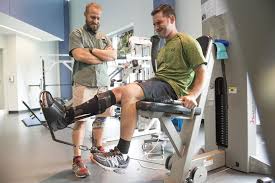Top 15 things to do to heal and rehabilitate your back, neck, elbow, shoulder, ankle, knee.
- Dr.Barry Triestman D.C.
- Jun 13, 2020
- 3 min read
Updated: Oct 9, 2020

The most important things you need to know to really heal your body!
Pay attention to your intuition, it knows a lot!
Get a great healthcare provider. See Dr. Triestman if your in Tahoe Truckee area or ask for a recommendation.
Be mindful of your movement, muscular control and pain. Practice your movement without distractions
Define your goal i.e. walk without a walker, run a marathon, play tennis, etc. and set mini goals to get you to the big ones.
Understand overload. To get the tissue of the human body to heal and get stronger we have to push OUR limits this stimulates protein synthesis and repair
There should be a specificity of rehabilitation/training meaning that the exercise that we do are similar to the activities that we want to be able to do. When we initially start, what we do may not look like the end goal but as we progress these exercises will look more similar. The closer the movements we do mimic the desired activities/goals the more efficiently they get us there and the better the results.
Do synergistic strengthening. When we talk about lower extremity function and use walking as goal. Then we can break it down into ankle/foot strength, knee strength, hip strength and core strength. If your knee is injured we initially can work the ankle, hip,and core. There will be synergistic carry over into knee strength and repair from working on the supportive/adjacent/synergistic parts of the body.
Use contralateral strengthening. If we use the knee as an example again. By strengthening the right the left gets stronger. I know, amazing.
Perform isometric strengthening, isometrics is a way to strengthen the muscles directly around a joint without moving it. Using the knee again, we do a wall squat. So we strengthen the quadriceps and hamstrings without moving the knee joint. Isometrics have a pain relieving effect also, so find a way to add them to work outs. We might also be able to progress to part of a range of motion. If the front part of the knee meniscus is injured then bending from 30-60 degrees might be the next progression in mimicking normal movement. Alway pay attention to what your body is telling you and adjust your progression.
Adjust the speed of the exercise. When you first start or feel pain or negative tension slow down your repetition speed. Pick up the speed as you get stronger.
Be mindful of your movement and your different body positions. Meaning that if you are watching tv or day dreaming about dinner the exercise benefit will decrease.
Use fatigue and recovery enhancement strategies. By doing this we encourage healing and well being. These would be things like active rest which is a day with a very light load. Or could be laughing, hot tub, time with family and friends and good nutrition.
Adjust to our lives demands. We need realize that in our "normal" lives we are pulled in many directions and we need to plan so that our goals don't get derailed.
Adjust and realize that we are affected by multiple things. Some tangible like our normal work activities and other activities like gardening mountain biking, tennis atc.. Some intangible like stress, emotions, and the angle of the moon.
Take the quiz below and get 100% and we know that you are on the road to recovery and performance.
Did you get it? Take the quiz and you will know!
Quiz
1. How do we tell when to regress aka backing off?
Increased tension in the injured area
More stiffness the next day especially in the morning
You know your going to have a crazy busy day
All of the above
2. How do you tell when to progress, aka doing a little more?
No pain
When the exercise has become to easy
You feel it is time
You have not increased the work in a while
All of the above
3. What are ways to enhance recovery.
Go on drinking binge
Eat sugary food
Have someone wake you every hour to limit your sleep
Get stressed
None of the above
4. We need to overload to progress and really heal?
True
False
5. Tissues need to get stronger then before we were injured so we don't re-injure ourselves.
True
False
6. Dr. Triestman has or will teach me most of this during our visits
True
False
7. Most medical and physical therapy programs don't push there clients hard enough in the long term. (they only prescribe a set number of repetitions and sets, not a progressive overload which is how injured tissues to get stronger)
True
False
The answers are question 1. is 4, question 2. is 5, question 3. is 5, question 4 is true, question 5 is true, question 6. is true, question 7. is true







Comments